ZEN MESTEREK ZEN MASTERS
« Zen főoldal
« vissza a Terebess Online nyitólapjára
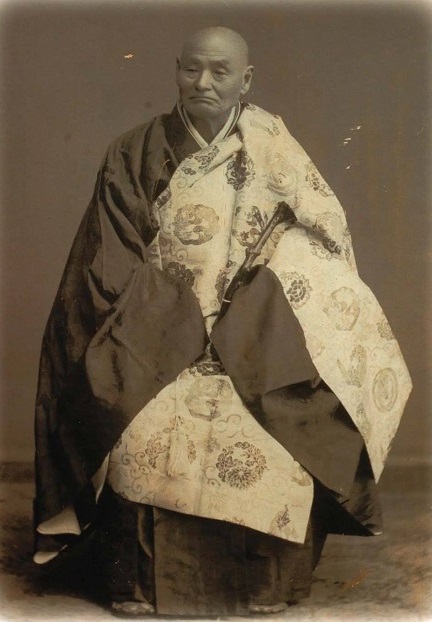
西有 (瑾英) 穆山 Nishiari (Kin'ei) Bokusan (1821-1910)
Honorific name: 直心浄国禅師 Jikishin-jōkoku zenji
Pen names: 可翁 Ka-ō; 無為庵 Mui-an; 有安老人 Yūan-rōjin
Chronology of
Bokuzan Nishi-ari's
life
by Nishijima Gudō Wafu
In: Japanese Buddhism and the Meiji Restoration, The American Academy of Religion, Society of Biblical Literature, Annual Meeting, November 22-25, 1997. San Francisco, pp. 10-12.
It would seem that the system of Buddhist thought expounded by Master Dogen and Master Nāgārjuna has been lost to present-day Buddhists in Japan. This makes it important to confirm whether their system of thought existed in pre-Meiji Japan or not. The problem can be clarified by looking at the recorded works of the monk Master Bokuzan Nishi-ari (Kin-ei). A brief chronology of his life is as follows:
1821 Born in Hachinohe City in Aomori Prefecture, the son of Chozaburo Sasamoto.
1833 Becomes a Buddhist monk under Master Choryu Kinryu in Choryu-ji Temple when he is 12 years old, and studies Buddhism there for 7 years.
1839 Moves to Sendai City and studies Buddhism under Master Ten-ou Etsu-on in Sho-on-ji Temple there.
1841 Enters the monastery of Kichijo-ji Temple in Edo (present-day Tokyo).
1842 Becomes a certified monk and receives the Transmission of Dharma from Master Anso Taizen in Hon-nen-ji Temple in Edo. Becomes Master of Horin-ji Temple in Edo.
1850 Becomes a student of Gettan Zenryu in Kaizou-ji Temple inKanagawa Prefecture, who is very famous for his study of the Shobogenzo.
1862 From 1862 onwards Nishi-ari becomes Master of the following temples in succession: Nyorai-ji (Shizuoka Pref.), Eicho-in (Kanagawa Pref.), Sosan-ji (Tokyo), Hosen-ji (Gunma Pref.)
After the Meiji Restoration in 1868, Buddhist monks are permitted to use their own family names, and so he registers his own family name as Nishi-ari.
1875 After 1875 he becomes Master of the following temples in succession: Hokou-ji Temple (Aomori Pref.,) Chu-ou-ji Temple(Hokkaido,) Kasuisai Temple (Shizuoka Pref.,) and Denshin-in Temple (Shizuoka Pref.)
1899 A sponsor builds a temple, named Saiyu-ji, for him in Yokohama City.
1901 Becomes Abbot of Soji-ji Temple (Ishikawa Pref.), one of the two main temples of the Soto Sect.
1910 Dies in Yokohama City on 4th December, aged 90 years.
From this biography we can see that Bokuzan Nishi-ari studied Buddhism in the Soto Sect tradition before the Meiji Restoration, and before Japan’s Universities exerted any influence on Buddhist thought. It is fortunate that his many lectures on the Shobogenzo have been recorded in his 正法眼蔵啓迪 Shōbōgenzō Keiteki [Edifying Comments on Shōbōgenzō] and are available today. Reading the records of his lectures we can get a clear picture of his understanding of Buddhism.
The Philosophy of Master Bokuzan Nishi-ari
by Nishijima Gudō Wafu
In: Japanese Buddhism and the Meiji Restoration, The American Academy of Religion, Society of Biblical Literature, Annual Meeting, November 22-25, 1997. San Francisco,
pp. 12-15.
PDF: Soto Zen in Meiji Japan: The Life and Times of Nishiari Bokusan
A thesis in Buddhsit Studies for UC Berkeley by Jiryu Mark Rutschman-Byler, 2014
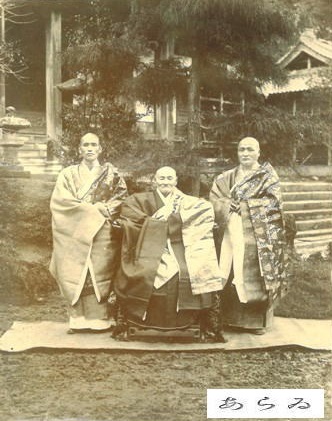
丘 (大潤) 宗潭 Oka (Daijun) Sōtan (1860-1921); 西有 (瑾英) 穆山 Nishiari (Kin'ei) Bokusan (1821-1910); 日置 (維室) 黙仙 Hioki (Ishitsu) Mokusen (1847-1920)
Photo taken at 修善寺 Shuzenji, 1905
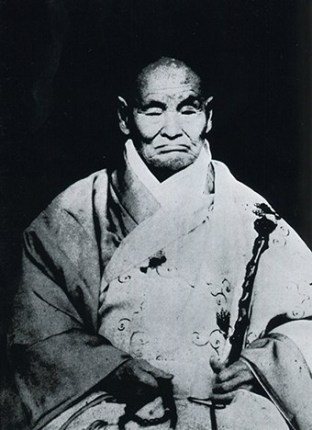
Nishiari Bokusan
of the age of 90 years
Dharma lineage
佛祖正伝菩薩戒 血脈
Busso shōden bosatsu-kai kechimyaku
Blood-vein of Bodhisattva Precepts Authentically Transmitted by Buddhas and Ancestors
永平道元 Eihei Dōgen ( 1200-1253)
孤雲懐奘 Koun Ejō ( 1198-1280)
徹通義介 Tettsū Gikai ( 1219-1309 )
螢山紹瑾 Keizan Jōkin ( 1 268-1325)
明峰素哲 Meihō Sotetsu (1277-1350)
珠巌道珍 Shugan Dōchin (?-1387)
徹山旨廓 Tessan Shikaku (?-1376)
桂巌英昌 Keigan Eishō (1321-14 12)
籌山了運 Chuzan Ryōun (1350-1432)
義山等仁 Gisan Tōnin (1386-1462)
紹嶽堅隆 Shōgaku Kenryū (?-1485)
幾年豊隆 Kinen Hōryū (?-1506)
提室智闡 Daishitsu Chisen (1461-1536)
虎渓正淳 Kokei Shōjun (?-1555)
雪窓祐輔 Sessō Yūho (?-1576)
海天玄聚 Kaiten Genju
州山春昌 Shūzan Shunshō (1590-1647)
超山誾越 Chōzan Gi n'etsu (1581-1672)
福州光智 Fukushū Kōchi
明堂雄暾 Meidō Yūton
白峰玄滴 Hakuhō Genteki (1594-1670)
月舟宗胡 Gesshū Sōko (1618-1696)
卍山道白 Manzan Dōhaku (1635-1715)
明州珠心 Minshū Shushin
密山道顕 Mitsuzan Dōken (1652-1736)
白堂香全 Hakudō Kōzen
公海慧然 Kōkai Keizen
泰麟道海 Tairin Dōkai
泰俊貫道 Taishun Kandō
泰巖曹隆 Taigen Sōryū
安窓泰褝 Ansō Taizen
穆山瑾英 Bokuzan Kinei (1821-1910) [西有 Nishiari]
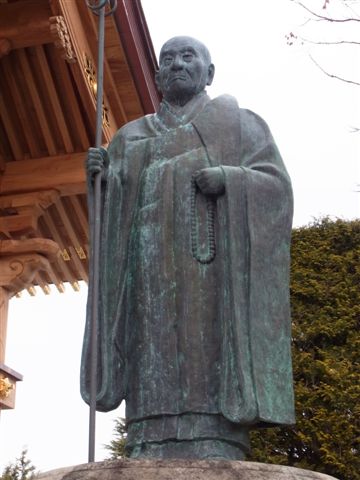
Nishiari Bokuzan (Kin'ei, 1821-1910)
by Stephen Addiss
In:
The Art of 20th-Century Zen: paintings and calligraphy by Japanese masters (with Audrey Yoshiko Seo), Shambhala, Boston, 1998.
pp. 109-117, notes: 204.
Dōgen's writíngs are extremely extensive and have served as the primary
teachings of Sōtō Zen in Japan to the present day, although there have been
times when his influence has slowly waned, only to be revived again by major
Sōtō Masters of later centuries. The leading monk who studied Dōgen
deeply in the later nineteenth and early twentíeth centuries was Nishiari
Bokuzan, also known as Kin'ei, whose editíons of Dōgen writings are still
current.Born in Aomori Prefecture to a family named Sasamoto, Bokuzan
was adopted by the Nishiari family as a child.[9] However, the family unexpectedly
had a son of their own, so Bokuzan left, never to return. Learning
young about the inconstancy of life, he entered the temple Chōryō-ji at the
age of nine (by Japanese count) and served as an attendant for seven years to
the monk Konryū. When Bokuzan was nineteen, Konryū retired, so the
young monk moved to Shōon-ji in Sendai, where he studied under Etsuon;
two years later he continued his studies in Edo (Tokyo) at Kichijō-ji. Continuing
to practice under leading masters, at twenty-two he studied with
Ansō Taizen of Hon'nen-ji in Edo and received his dharma transmission. Although
Bokuzan served as abbot of Hōrin-ji in Edo, he contimled to seek out
teachers, studying with Guzen at Kichijō-ji in Edo and gaining his dharma
transmission in 1849. The following year, Bokuzan returned to his native village
to visit his mother, who welcomed him with great warmth. He then
continued on to Kaizō-ji in Sagami, where he heard a lecture on the meditation
sutra Ryōgon-kyō from 月潭全竜 Gettan Zenryū and had a powerful enlightenment
experience, which Gettan acknowledged.Upon the completion of his training, Bokuzan served as abbot of several
different Sōtō ternples, becoming a Zen master at the age of forty-four
when he relieved Gettan, who had become ill. However, as has been mentioned
earlier, Buddhism experienced a crisis during the Meiji period (1868-
1912), since it was considered a "foreign religion" as cornpared with Shinto,
and therefore lost its primary government support. Bokuzan was one of the
monks during this turbulent period who worked to revive and strengthen
Sōtō Zen. Since he had developed a reputation as an outstanding scholar-
monk, he was one of three monks given responsibility for the Sōtō Education
Bureau in Tokyo in 1872, and he advanced in ranks and responsibilities
as the Sōtō sect adjusted to the new governmental regulations.In 1873 Bokuzan, along with several senior monks of the Rinzai sect,
protested a new directive that monks should wear everyday clothing. Arguing
that the Buddhist tradition would suffer, they succeeded in overturning
this decision. Furthermore, aware that the new national focus upon education
would be a major factor in the changes that Japan was undergoing,
Bokuzan devoted much of his time to Buddhist teachings. He gave a series
of successful lectures in Tokyo, and became the Assistant Director of the
Sōtō Educational Bureau in 1874, Associate Director the following year, an
Director in 1883. During this time he also continued his ternple activities, es-
pecially after 1875 when he was appointed abbot of Hōkō-ji in Mutsu.It seems that Bokuzan was involved in almost all the major movements
taking place in Japan at this time. For exarnple, in the early Meiji period
there was a concerted effort by the Japanese government to control and
develop the northern island of Hokkaido, so Bokuzan traveled there to over-
see the development of Buddhist education. He so impressed the govemment
envoy Miyamatsu Honjūrō that he was given a large plot of land, upon
which he organized the building of a ternple that is now known as Chūei-iAs a leading Buddhist cleric, in 1876 Bokuzan had an audience with
the Emperor at the temporary Imperial headquarters in Aomori, and two
years later he was granted another audience. The year between these presti-
gious occasions, Bokuzan moved to Kasui-sai in Tōtōmi, where he built a
Buddhist school in 1881 called Manshō Gakkō (School of Ten Thousand
Pines). Continuing his rise in the Buddhist hierarchy, Bokuzan was granted
the right to wear the Yellow Robe of honor in 1886. However, he never lost
his understanding of the transience of all worldly matters, including success
and honors, which is very clear when we examine his art.
Bokuzan did both Zen painting and calligraphy; what might we ex-
pect to see in the works of such a scholar-monk? One example of his calligraphy
seems both modest and scholarly, since it consists of a poem and prose
inscription written in small size on silk (PLATE 53). Yet this scroll exemplifies
Bokuzan's inner feelings as he faced a changing Japan, seeing underneath
the changes some age-old truths. The inspiration for this work came in 1890
when Bokuzan, age seventy, visited a pavilion in Ryōga where two verses
were inscribed. The poets were Yamanouchi Yōdō (Toyoshige, 1827-1872)
and Kido Takayoshi (1833-1877), both of whom had been major figures in
the Restoration of the Meiji Emperor.Moved both by the beauty of their poems and by the evanescence of
human life, Bokuzan wrote his own quatrain that alludes to a famous Chinese
story. This tale, by the T'ang-dynasty author Li Kung-tso (c. 770-c. 848)
recounts that an official fell asleep under a locust tree and dreamed of a life
in which he found fame, fortune, and marriage while he governed a southern
province. When he woke up, he noticed that under the "southern
bough" of the locust tree there was a busy anthill. This colony of ants had
been his dream world.The idea of another reality within a dream was not new in China. Li
Kung-tso's story was based upon an earlier tale by Shen Chi-chi called "The
World Inside a Pillow," which itself harkened back to the Taoist sage Chuang-tzu
dreaming that he was a butterfly. When he woke, he wondered if he was
really Chuang-tzu, or just the butterfly now dreaming it was a person?AlI these tales emphasize the transitory and illusory nature of what we
regard as reality and provide the focus of Bokuzan's poem and commentary:His Excellency of the Eastern Sea and His Excellency
of Chrysanthemum and Pine
Once serenely visited this pavilion,
experiencing complete joy!
But true it is that reputation
is a "Dream of Locust Peace"
Their lovely lines remain inscribed,
but they have disappeared.-His Excellency of the Eastern Sea, Yamanouchi, together with
His Excellency of Chrysanthemum and Pine, Kido, once visited
the Pavilion of the God's Substitution at Ryōga Village and
wrote poems. The two gentIemen are both deceased. I have now
happened to visit this pavilion, and I have been moved.
Bokuzan, 70 and residing beside the sea.[10]The underlying theme of the poem, that earthly glory is fleeting, has
long been a Buddhist truth, but it would have had a special meaning to those
living during an era of such great disruptions in Japan. For their roles in the
Meiji Restoration of the Emperor, Yamanouchi Yōdō and Kido Takeyoshi
were considered great heroes. Yet by the year 1890 when this scroll was created,
they had both been dead for more than a decade, and all that remained
of their glory for Bokuzan to experience was the poems inscribed in the pavilion.
Similarly, when we now view the poem and calligraphy by the Zen Master,
we may well ask, where is the reality in this locust dream?The scroll itself is written in running-cursive script on high-quality
silk, with the poem occupying the first three columns, the commentary the
next three (slightly indented from the top), and the signature the final line.
Bokuzan's calligraphy is bold and confident, creating a sense of motion with
the characters sometimes tilting to the right or left. The medium of silk allows
the ink to fuzz, most visibly on the first character, softening the otherwise
intense rhythm of curved and angular strokes. At the end of the third
column, the final character of the poem (空) empty, disappeared) is larger
and set off to the left, giving it extra emphasis. This character also show
Bokuzan's typicaily forceful hooking stroke that appears dynamically in
many of his works of painting and calligraphy. Although this poem is small
and seemingly quiet, upon close viewing the ink seems to be emblazoned
into the silk, and each stroke of the brush demonstrates the sense of disciplined
energy and inner conviction that marks Bokuzan as a Master of both
Zen and visual art.Bokuzan did not let his understanding of transience deter him from
his responsibilities in the changing aspects of religion in Japan. In 1892 he
became the Tokyo representative of Sōtō Zen, receiving the appointment to
manage the offices of the sect from the Interior Minister of the Meiji government.
That year he officially retired from temple duties, giving him more
time for scholarly writing in order to strengthen Buddhist teachings during
an age strongly committed to education. For this purpose he turned to the
words of the Japanese founder of the Sōtō sect, Dōgen. Although Bokuzan
wrote many books during his long life, the study of Dōgen's magnum opus,
Shōbōgenzō, was his major task. In 1896 he published the Shōbōgenzō shiki
(Private Record of the Shōbōgenzō) and the Shōbōgenzō kōgi (Lectures on
the Shōbōgenzō). These books, along with his Shōbōgenzō keiteki (An Explanation
of the Shōbōgenzō), remain important sources for both Dōgen's
thought and the study of Sōtō Zen.Although Bokuzan had retired, in 1900 some of his followers resolved
to build a temple in Yokohama in his honor. They named it Saiyū-ji, using
a Chinese-style reading of his family name Nishiari as Saiyū. He was persuaded
to become the official founder of the temple, but the following
spring, at the age of eighty-one, Bokuzan could not refuse the request to be-
come the third abbot of the headquarter Sōtō temple Sōji-ji in Ishikawa. In
honor of his achievements, on June 19 of that year he was given the honorary
Zen title of Jikishin Jōkoku Zenji (Honest Heart Pure Nation Zen Teacher).
In 1902 Bokuzan was elected to a two-year term as Kanchō of the entire Sōtō
sect, a position to which he was reelected in 1904. That June he was given
the first chair at an all-Japan Buddhist Education conference, but in December,
feeling the press of his years, he resigned as Sōtō Kanchō, and the
following February he also withdrew from Sōji-ji, retiring to Saiyū-ji where
he spent his final five years.
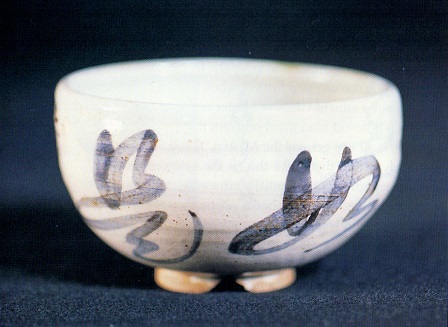
During his final retirement, Bokuzan continued his painting and calligraphy.
For a scholar-monk, the poem he had written in 1890 with its references
to the Chinese past might be expected, but an inscription on a
teabowl by a monk in his late eighties must seem more unusual (PLATE 54).
Yet this inscription is perhaps even more meaningfuI, because it proclaims a
fundamental Zen two-word phrase: "like this!" (如是). This inscription,
which can also be translated "just this," along with the dynarnic quality of
this calligraphy, makes clear that Bokuzan was not merely a scholar but also
a Zen Master. He has written the two characters in underglaze blue with
bold curving brushwork in fully cursive script--the first word is written with
two strokes and the second with a single stroke of the brush. Not shown in
the illustration, to the left of the inscription is his signature in underglaze
iron-brown, "Written by Bokuzan, formerly of Sōji-ji." The bowl itself was
made in Oribe style, with a rich green glaze covering one section of the pitted
and crackled white glaze over light brown clay.What does "like this!" or "just this!" mean? There are several Zen stories
from China that relate to this phrase. In one, Dongshan asked Yunyan,
"After your death, if some one asks me if I can describe your reality, how shall
I reply?" After a while Yunyan said, "just this is it." In another story, the Master
Yantou said "If you want to know the last word, just this is it."[11]Taking this one step further, when asked a cosmic question about the
Buddha, one eminent Chinese Master replied, "Have a cup of tea." In this
way Zen is different from many religions that emphasize life in the hereafter;
"just this' is all you get, say the Masters. Dōgen, whom Bokuzan studied so
extensively, wrote that "'like this' is the body-mind of right now."[12] This
sense of the ordinary as potentially extraordinary has animated much of later
Japanese culture, including haiku poetry, flower arranging, garden design,
ink painting, and tea. All of these arts combine a sense of nature, an intensity
of focus, practice rather than intellection, and an appreciation of empty
space in which that which cannot be said and cannot be shown--can exist.There are other reasons why Zen Master Bokuzan inscribed a
teabowl. We may now consider cha no yu (usually translated as "tea ceremony")
as a formal and complex discipline, but at its heart it is nothing more
than heating water and drinking tea. In Zen, as in tea, discipline is essential
in learning how to quiet the mind, not to construct an identity, but rather to
strip away illusions. We are told that when sitting, just sit; reading a book,
just read; the world is constantly changing, so there is no immutable self,
past or future. What is left? Just this!
A third work by Bokuzan, Three Buddhist Jewels (PLATE 55), has the
inscription: "Fukuju nyoi!" These four characters have three possible
translations:Happiness and longevity as you wish!
Happiness and longevity scepter!
Jewels of happiness and longevity!
The key two-character word 如意 nyoi literaIly means "as one wishes" but
can also mean a scepter, about fifteen inches in length with a slight S-curve.
It is usually carved from jade, bamboo, or wood, and is said to resemble the
mushroom of immortality. This scepter was originally carried by Taoist
adepts and then became a symbol of Zen Masters; they somethimes brandish
it during their public teachings and occasionally may also find it useful
to whack a disciple who is just ... not ... getting ... it. In Buddhism, the
nyoi also has wish-fulfilling connotations, especially because with one more
character added it becomes the 如意樹 nyoi-ju, or wish-giving jewel, called cintamani
in the original Sanskrit.In some forms of Buddhism, as in other religions, people pray for
their wishes to be fulfilled, and this jewel is revered as a symbol of good fortune.
But what about Zen? For those not expecting anything beyond "just
this," what can the Buddhist jewel mean? Perhaps this is exactly the question
that Zen Masters want us to ask. There is a koan, the ninety-third from
the collection translated as The Book of Serenity, that deals directly with this
issue:INTRODUCTION
A precious gem hits a magpie, a rat bites a gold piece-they don't know they
are treasures, and can't put them to use. Is there anyone who suddenly notices
this jewel hidden in his clothes?CASE
Luzu asked Nanquan, "'The wish-fulfilling jewel, people don't know--it is personally
obtained from the mine of realizetion of thusness.' What is this mine?"
Nanquan said, "That in me which comes and goes with you is it."
Luzu said, "What about that which doesn't come and go?"
Nanquan said, "lt's also the mine."
Luzu said, "What is the jewel?"
Nanquan called him by name: Luzu responded, "Yes?"
Nanquan said, "Go--you don't understand my words."[13]Difficult kōan such as this are given to Zen students well along in their training,
and the answers are not expected to be easy. However, there are two interesting
passages in the commentaries to this kōan that offer it added
richness. The first is the opening quatrain of the accompanying verse:Distinguiehing right and wrong, clarifying gain and loss.
Responding to it in the mind, pointing to it in the palm.
Coming and going, not coming and going--
lt's just this--both are the mine.The second comment is by the Zen Master Dongshan (Tung-shan): "It's not
that there is no joy; it is like finding a lustrous jewel in a heap of trash."[14]
Dōgen included this kōan in his own collection, the Three Hundred
Kōan Shōbōgenzō, number 185, with a new prologue and capping verse:PROLOGUE
It includes heaven and encompasses the earth. It is beyond the sacred and the
secular. Revealed on the tips of a hundred thousand weeds--the wondrous
mind of Nirvana, the exquisite teachings of formless form. From deep within
the forest of brambles, the light of the mani pearl is released. This is the
adamantitie eye of the adept.CAPPING VERSE
It illuminates itsel{,
The solitary light of one bright pearl.
No ... It illuminaies the ten thousand things.
See-- there are no shadows.
When looking, who does not see?
Seeing, not seeing--Bah!
Riding backward on the ox
Distant mountains endlessly unfold."Dōgen also wrote even more directly: "Everyone holds a precious jewel, all
embrace a precious gem; if you do not turn your attention around and look
within, you will wander from home with a hidden treasure."[16]Bokuzan, in his painting and inscription, suggests meanings through
his art that go beyond the image and words themselves. The three jewels are
not depicted as still and serene, but rather moving, falling, bouncing
through space in a very lively and dynamic way. Two smaller, darker jewels,
tilted into active positions, overlap a larger gray one, and all three send forth
antennae up toward the calligraphy. The words echo these shapes, especially
the curves at the botlom of the second and fourth characters, which
are upside-down echoes of the antennae. What is the effect? It is clear that
the image and words, like the jewels, are not separate but interacting, part of
a process that is always moving and changing-like the distant mountains in
the verse, endlessly unfolding.As is the case with many Zen Masters, Bokuzan seems to have done
the majority of his works of art in his final years, as a kind of distillation of his
wisdom and experience through a medium that uses words but does not depend
entirely upon them. Death finally came to Bokuzan on December 4,
1910, at the age of ninety. Like many earlier Zen Masters, he composed a
death poem as his final act:An old monk of ninety years,
My words end, my speech ends;
But there is no end to the poem:
The moon is cool, the wind is cold.
NOTES
9. The most reliable biography of Bokuzan is given in Sōtōshū jinmei jiten (Sōtō
Sect Biographical Dictionary) (Tokyo: Kokusho Kankōkai, 1977), pp. 63-64.
10. Translation by Jonathan Chaves, who also provided the information on Li Kung-
tso.
11.These stories are given in a Chinese kōan compendium translated by Thomas
Cleary as The Book of Serenity (Hudson, N.Y.: Lindisfarne Press, 1990), pp. 206
and 211.
12. Translated from Dōgen's Shōbōgenzō by Thomas Cleary in Rational Zen: The
Mind of Dōgen Zenji (Boston and London: Shambhala, 1995), p. 100.
13· Ibid., p. 398.
14· Ibid., pp. 400 and 399·
15. Translation from John Daido Loori, Two Arrows Meeting in Mid-Air (Boston and
Rutland: Charles E. Tuttle, 1994), pp. 17-18, where this kōan is presented and
discussed.
16. From Dōgen's Eihei Kōroku, translated by Thomas Cleary, Rational Zen, p. 59.
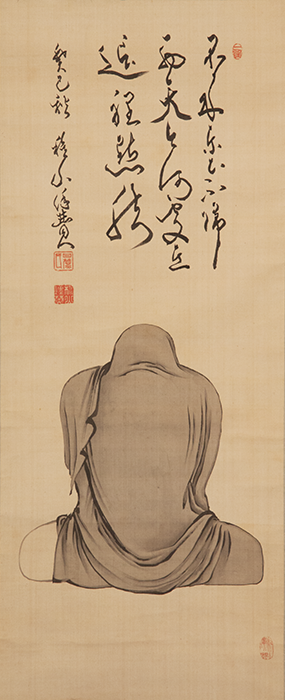
Daruma

Daruma

達磨図 一華五葉に開き 結果自然に成る 八十穆山自画
Painting of Bodhidharma. The five petals of the one flower open, and the fruit of itself is ripe. Painted by myself Bokuzan 80 years old.



1) Three Buddhist Jewels; 2) Skull; 3) Dragon

歿朆丅徇亹
The years and months do not wait for humans
Les années et les mois n’attendent pas l’être humain
Calligraphy by Zen Master Nishiari Bokuzan